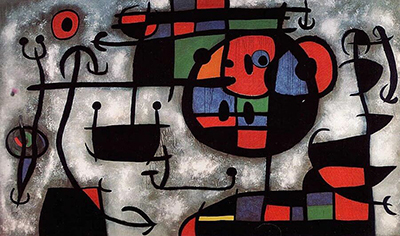The Skiing Lesson is a painting by Joan Miro which was completed in 1966. There is a wealth of detail to this piece, but it is still somewhat difficult to identify particular elements within the scene.
The artist puts a grey background across the entire canvas which is delivered in a smoky style which he would use many times across the latter part of his career. This created a moody atmosphere with a sense of an organic environment, but he would then add much more precise items on top. There is a whole myriad of black lines throughout the painting, some curved and some straight. Arrows curve at the ends of some of these lines, almost forming abstract smiles. The lines cross over in order to create different shapes in the space that remains. Some of the shapes that form between these intersecting lines are filled with bright tones of colour, with reds, blues and greens bringing a real life and energy to the painting. In the top left there is a red circle with a black circle inside which resembles perhaps a human eye. A central part also looks similar to a human head, with an ear coming out from the side, but this may just be coincidence.
Miro purposely chose to reject traditional art from an early age and find new ways of expressing his ideas. The bold use of colour and clear shapes became prominent within his work after a few years, though the transition was slow and involved more of an evolution, rather than an abrupt new direction. Miro was also entirely respectful of more traditional art, and studied it as a student, but simply did not want to just rehash old ideas within his own oeuvre. He was joined by a number of like minded individuals and together they would build up a much stronger momentum which then started to receive interest from the public. You will find some influences in his work from others of the time, such as in his Cubist paintings, but he was keen to remain fairly unique as best he could.
In keeping with his attempts to re-imagine art, there is no real start and end to this painting, no sense of one part being more important than another. It is almost as if the artist just allowed his mind to wander, creating different forms as he moved from the centre of the painting outwards, with no desire to produce anything from reality, and really just run wild. Colour is key here, an the balance of bright tones with the black lines and shapes which helps to produce a really impactful artwork, though this was very much the style that the artist used for several decades, once his path to abstraction had been completed in his latter years. The Skiing Lesson, as the title, does get us wondering as to whether we are looking at several narrow skis, and perhaps a boot from a side on view, making the head a deliberate addition.




